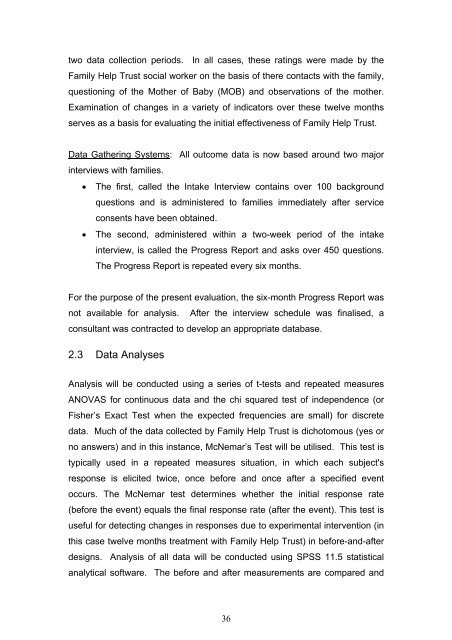Evaluation of Family Help Trust - New Zealand Family Violence ...
Evaluation of Family Help Trust - New Zealand Family Violence ...
Evaluation of Family Help Trust - New Zealand Family Violence ...
You also want an ePaper? Increase the reach of your titles
YUMPU automatically turns print PDFs into web optimized ePapers that Google loves.
two data collection periods. In all cases, these ratings were made by the<strong>Family</strong> <strong>Help</strong> <strong>Trust</strong> social worker on the basis <strong>of</strong> there contacts with the family,questioning <strong>of</strong> the Mother <strong>of</strong> Baby (MOB) and observations <strong>of</strong> the mother.Examination <strong>of</strong> changes in a variety <strong>of</strong> indicators over these twelve monthsserves as a basis for evaluating the initial effectiveness <strong>of</strong> <strong>Family</strong> <strong>Help</strong> <strong>Trust</strong>.Data Gathering Systems: All outcome data is now based around two majorinterviews with families.• The first, called the Intake Interview contains over 100 backgroundquestions and is administered to families immediately after serviceconsents have been obtained.• The second, administered within a two-week period <strong>of</strong> the intakeinterview, is called the Progress Report and asks over 450 questions.The Progress Report is repeated every six months.For the purpose <strong>of</strong> the present evaluation, the six-month Progress Report wasnot available for analysis. After the interview schedule was finalised, aconsultant was contracted to develop an appropriate database.2.3 Data AnalysesAnalysis will be conducted using a series <strong>of</strong> t-tests and repeated measuresANOVAS for continuous data and the chi squared test <strong>of</strong> independence (orFisher’s Exact Test when the expected frequencies are small) for discretedata. Much <strong>of</strong> the data collected by <strong>Family</strong> <strong>Help</strong> <strong>Trust</strong> is dichotomous (yes orno answers) and in this instance, McNemar’s Test will be utilised. This test istypically used in a repeated measures situation, in which each subject'sresponse is elicited twice, once before and once after a specified eventoccurs. The McNemar test determines whether the initial response rate(before the event) equals the final response rate (after the event). This test isuseful for detecting changes in responses due to experimental intervention (inthis case twelve months treatment with <strong>Family</strong> <strong>Help</strong> <strong>Trust</strong>) in before-and-afterdesigns. Analysis <strong>of</strong> all data will be conducted using SPSS 11.5 statisticalanalytical s<strong>of</strong>tware. The before and after measurements are compared and36












